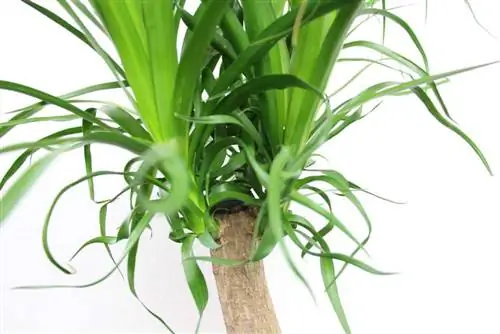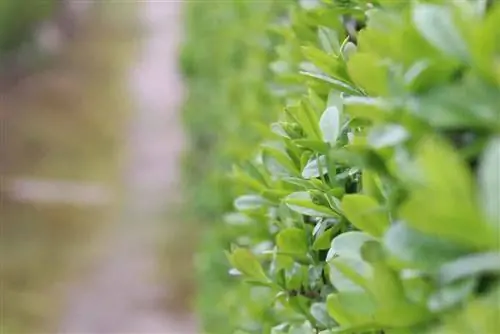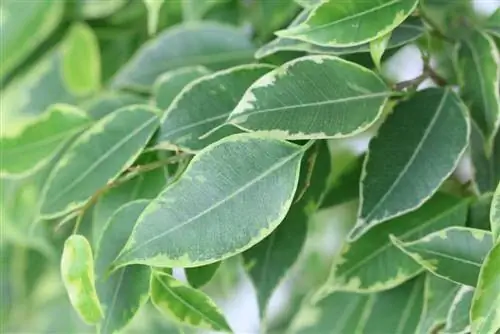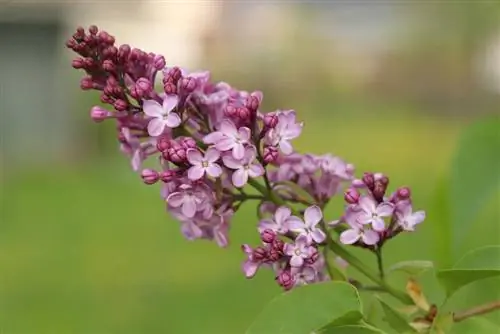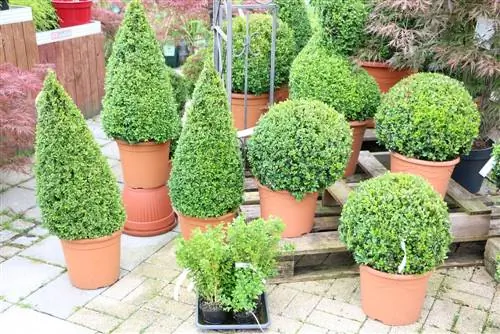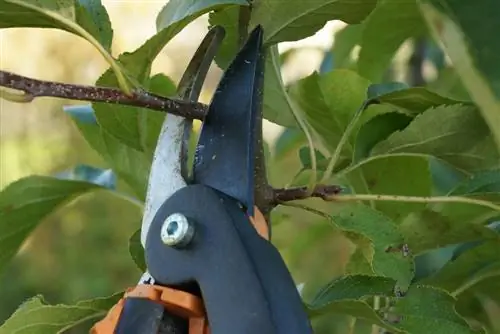- Author admin [email protected].
- Public 2023-12-17 03:39.
- Last modified 2025-01-24 12:45.
As they get older, yucca palms sometimes lose their shapely shape. They hit the ceiling, threaten to tip over, form thin stems with stunted leaves due to a lack of light and spread a sad atmosphere. It's high time for a rejuvenation treatment that goes hand in hand with a courageous pruning. How to properly prune yucca palms should no longer remain hidden from you. The following practical instructions for hobby gardeners show you how to rejuvenate palm lilies perfectly.
Time
Although pruning a yucca palm is possible throughout the year, the weeks from the end of March to mid-May are particularly recommended. The palm lilies are not yet fully saped at this stage, so that the inevitable cuts do not bleed too much. Cutting back the agave plants during the winter vegetation period has the disadvantage that the chances of a possible proliferation of the trunk pieces are next to zero.
Material requirements
In addition to choosing the ideal date for rejuvenating palm lilies, the quality of the tools and work materials have a decisive influence on the successful completion of the measure. If you want to properly prune yucca palms, you should be equipped with these supplies:
- a sturdy fretsaw
- alternatively a sharp bread knife
- a small knife with a smooth cutting surface
- Work gloves to protect against the sharp blade edges
- several pots with bottom opening as water drain
- Palm soil or potting soil, sand and perlite
- crushed pottery shards, pebbles or grit
- Tree wax or similar wound closure agent
Although yuccas are incorrectly referred to as palm trees, their trunks have a similar strength to real palm trees when they are older. The cutting tool should therefore be freshly sharpened so that the cuts do not fray unnecessarily. Careful disinfection is also an advantage in order to prevent lurking fungal spores and bacteria from having any chance of attack.
Pruning instructions
Once all the materials are ready, the work can begin. It is completely normal for an inexperienced hobby gardener to be plagued by reservations. In this case, consider the actual botanical nature of a palm lily. The trunks only visually resemble a real palm tree trunk. While palm trees usually have a single point of vegetation near the crown, woody yuccas have numerous sleeping eyes directly below the bark. If you prune yucca palms correctly according to these instructions, the plants will sprout again from these dormant nodes within a short time.
- Cut the trunk back to the desired height in 20-30 cm long segments.
- Straighten the interfaces with the smooth knife.
- Immediately mark the polarity on each section if propagation is planned.
- Treat each cut with tree wax or wound closure agent.
- Alternatively, seal with charcoal ash.
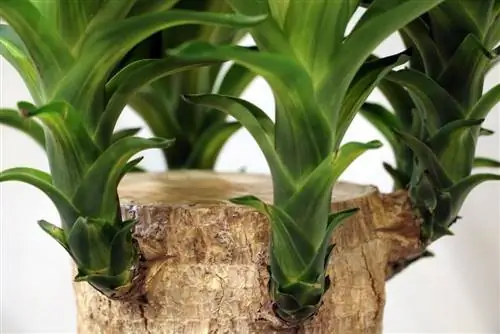
It is advisable not to completely close the cuts with tree wax. It has been found that it is completely sufficient if the edges of the wound are smeared with the preparation. In this case, no moisture can build up under the seal, which in the worst case can lead to rot.
Repotting rejuvenated palm lilies
When you prune yucca palms, you are putting the plants under extreme stress. The chances of rapid regeneration are better if you transplant the rejuvenated trunk base with the root ball into fresh substrate. Here's how to do it:
- the previous bucket can be reused
- alternatively, choose a new pot that is only slightly larger
- create a drainage over the floor opening made of potsherds, pebbles or grit
- spread an air- and water-permeable fleece over it so that the drainage doesn't get blocked
- fill the planter halfway with a mix of substrate and sand or perlite
- insert the potted palm lily in the middle, fill the cavities with potting soil and water
If the root ball is exposed, experienced hobby gardeners take a close look at it. Root strands that appear unhe althy are cut out at this opportunity. If the bale is very compacted, score it 0.5 cm deep in two or three places with a cutter knife. Alternatively, loosen the root area with both hands.
Cuttings are used for propagation
After pruning yucca palms, you will have a lot of suitable material for breeding additional specimens. For this purpose, knowledgeable hobby gardeners mark the direction of growth on the trunk segments during rejuvenation. If the polarity is not correct during propagation, the entire project is doomed to failure. This is how you treat the trunk pieces correctly:
- Fill the pots provided with drainage and a palm soil-sand mixture.
- Alternatively, use a lean, well-drained potting soil.
- Plant half of a trunk segment in each planter, taking into account the previous growth direction.
- Water the substrate to cover the pot with a plastic bag.
Set up in a warm, bright location, the stem cuttings sprout from the sleeping eyes within a few weeks. As soon as the first shoots appear, the cover is removed. A dose of diluted liquid fertilizer has a beneficial effect on the further rooting process. The plants must be kept constantly moist throughout the entire period without causing waterlogging. Once the young shoots have developed into new leaves, repot the plants into substrate for adult Yucca palms.
Tip:
The lower rows of leaves are removed from leafy stem cuttings and placed in a container with water for rooting. The addition of a piece of charcoal reduces the risk of rot.
Plant stem cuttings crosswise
If you neglected to mark the direction of growth when pruning, you don't have to stop propagating it. In this case, cut the trunk segments so that they fit crosswise into a growing pot. Plant the cuttings there so that they are not completely covered with substrate. New shoots also sprout vertically towards the sky from the knots beneath the bark in the warm, bright place.
Palm lilies rejuvenate by removing moss
A variant for rejuvenating yucca palms that uses the moss removal method. For this purpose, choose the height to which the palm lily should be cut back. At this point, loosen a piece of the bark and cut the trunk diagonally with a sharp, disinfected knife. Then take a plastic pot, cut it open and enlarge the drainage hole so that you can place it over the trunk of the palm lily. The planter is fixed with padded wires so that it can then be filled with potting soil. During the following days and weeks, the substrate is kept slightly moist. Initially, delicate roots form from the incisions, which over time form a dense network. This is the signal to cut the yucca stem below the container. From this point on you have a self-sufficient young plant in your hands that is cultivated according to a tried and tested pattern. The cut on the mother plant will then also sprout again and develop a pretty tuft of leaves.
Conclusion
If yucca palms grow over your head or become unsightly, cutting them back will help. Don't be confused by their palm-like habit, as yuccas have numerous sleeping eyes under the bark. If yucca palms are pruned correctly, pretty new leaves will sprout from these vegetation points within a short period of time. To rejuvenate palm lilies to the desired extent, simply cut off the trunks. At the same time, you have vital cuttings in your hands that can be used for easy propagation. When potted in potting soil or in a glass of water, rooting takes place quickly. Alternatively, you can use the moss method to shape a palm lily and at the same time grow new specimens.
What you should know about cutting yucca in brief
The plant doesn't require much care, grows quite quickly and is a feast for the eyes in any room. However, yucca palms also grow quite large and often reach the ceiling. What should be done then? You simply cut the yucca palm as follows:
- You can cut the plant at any height.
- The best time for this is in spring.
- Use a sharp knife to cut. Bread knives with a fluted blade are cheap.
- It's better to wear gloves when cutting a yucca! Some species have sharp-edged leaves.
- From the trunk that is left standing, the yucca usually sprouts reliably in several places.
Seal the cut surface
- Sealing prevents drying out.
- Besides, such a dry trunk doesn't look pretty.
- The easiest way is to light a candle and drip wax onto the cut site.
- You can of course also use tree wax or wound closure products for pruning.
Use cut yucca parts as cuttings
- The cut parts usually root easily and can be used for new plants.
- You simply put the pieces in a glass of water.
- It is best to remove the leaves, this way the stem pieces will root the quickest.
- If you leave the leaf bases intact, it will take a little longer, but it also works.
- You have to be careful that the leaf bases under the water surface don't start to rot!

